Lake Formarinsee to Lake Spullersee Day Hike, Vorarlberg (original) (raw)
This spectacular day hike in the idyllic Lechquellen Mountains is one of our newest additions to Best Day Hikes in Austria.
We loved this trail because of the pristine scenery (no ugly ski infrastructure), the awe-inducing alpine views of the Lechquellen and Verwall groups, and the terrain variation. It’s never boring – not for a single moment!
This point-to-point hike in Lech am Arlberg, Vorarlberg, requires the use of bus transit. Starting in Lech am Arlberg, take Bus 7 to Lake Formarinsee (30 minutes).
From Formarinsee, hike 11.3 km across the Steinernes Meer (“Stone Sea”) and over the Gehrengrat ridge, before descending to Lake Spullersee. From Spullersee, hop on Bus 6 back to Lech am Arlberg.
Keep reading for detailed transit and trail descriptions.
- Formarinsee – Spullersee Hiking Map
- How Difficult is the Hike from Formarinsee to Spullersee?
- How to Get to Formarinsee Lake
- Lake Formarinsee to Lake Spullersee Trail Description
- How to Get Back to Lech am Arlberg from Spullersee
- Where to Stay
- Austria Trip Planning Essentials
- Vorarlberg Hiking Trails

- Starting Point: Formarinsee Bus Stop | Google Maps
- Ending Point: Spullersee Bus Stop
- Distance: 11.4 km point-to-point
- Time Needed: 4:30 hours
- Elevation Gain: 637 meters
- Elevation Loss: 673 meters
- Difficulty: Moderate in dry conditions. Difficult in wet conditions
- Minimum Elevation: 1821 meters
- Maximum Elevation: 2428 meters
- Route: Formarinsee (Lake) – Freiburger Hütte (Mountain Hut) – Steinernes Meer (Karst Landscape) – Gehrengrat (Mountain Ridge) – Dalaaser Schütz (High Alpine Valley) – Spullersee (Lake)
- Where to Eat: Freiburger Hütte
- Responsible and Safe Hiking in the Lechquellen Mountains: During this hike, you’ll likely encounter grazing cattle. Do not pet, or approach cows. Give them a wide berth. With the exception of hiking around cows, stay on marked trails and make sure to pack up all your garbage.
- Where to Stay in Lech: Lech Hostel (budget), Hotel Garni Schneider (midrange), Hotel Auenhof (4-star), or Hotel Der Berghof (4-star superior)
- Where to Stay in Oberlech: Hotel Sonnenburg (luxury)
- Recommended Trail Map: WK 5504 Arlberg 1:35 000 (Freytag + Berndt)
Formarinsee – Spullersee Hiking Map
How Difficult is the Hike from Formarinsee to Spullersee?
In dry conditions, this hike is moderate to difficult, depending on your alpine hiking experience. In wet conditions, this hike is very slippery and a bit treacherous due to the loamy terrain.
Specifically, there are two parts of this trail that we’d deem “moderately difficult:” crossing the karst Steinernes Meer and the initial descent from Gehrengrat.
Steinernes Meer. To hike across the Steinernes Meer, you need to have very good balance and surefootedness, because the terrain is very uneven. You must skillfully navigate slabs of karst pavement.
Gehrengrat. As you descend from Gehrengrat ridge in the direction of Lake Spullersee, the trail is washed out and unstable in some places. Hiking poles are extremely helpful in stabilizing your descent. We saw a lot of people struggling.
How to Get to Formarinsee Lake

Lech am Arlberg
Purchase a Lech Card
If you’re spending more than one day in Lech am Arlberg, it makes sense to invest in a Lech Card.
It’ll save you a lot of money in transit costs (bus, gondola, chairlift, cable car, etc…) and make your overall transit experience a whole lot smoother. Pricing Lech Card.
You can purchase Lech Cards at the tourist office in Lech am Arlberg, or in your hotel.
If you don’t have a Lechcard, it costs 20 EUR (total) to travel from Lech to Formarinsee and back to Lech from Spullersee.
Take Bus 7 from Lech am Arlberg to Formarinsee
Bus Stop | Lech Rüfiplatz, next to the fountain and the wooden-covered “Tannbergbrücke” bridge | Google Maps
Transit Times | You’ll find the current timetable (local bus) at the bus stop. Usually, there are 8 departures during the day.
Duration | 30 Minutes
From Lech, the bus heads to Zugertal Valley, passing Zug, Spullerswald Forest, Gasthaus Älpele, and Tannlageralpe.
The road runs parallel to Lech River, so you’ll see the Lechweg (Lech River Trail, 1st stage) during the ride.
Drive to Formarinsee
We do not recommend driving to Lake Formarinsee during the official summer season.
However, if you’re arriving in Lech before/after the summer buses are operating, you can drive to Formarinsee. There is a 20 EUR toll fee.
When buses are operating, it’s also possible to drive to the lake before 8:00 am or after 4:30 pm.
Lake Formarinsee to Lake Spullersee Trail Description
Formarinsee to Freiburger Hütte (35 – 45 minutes)
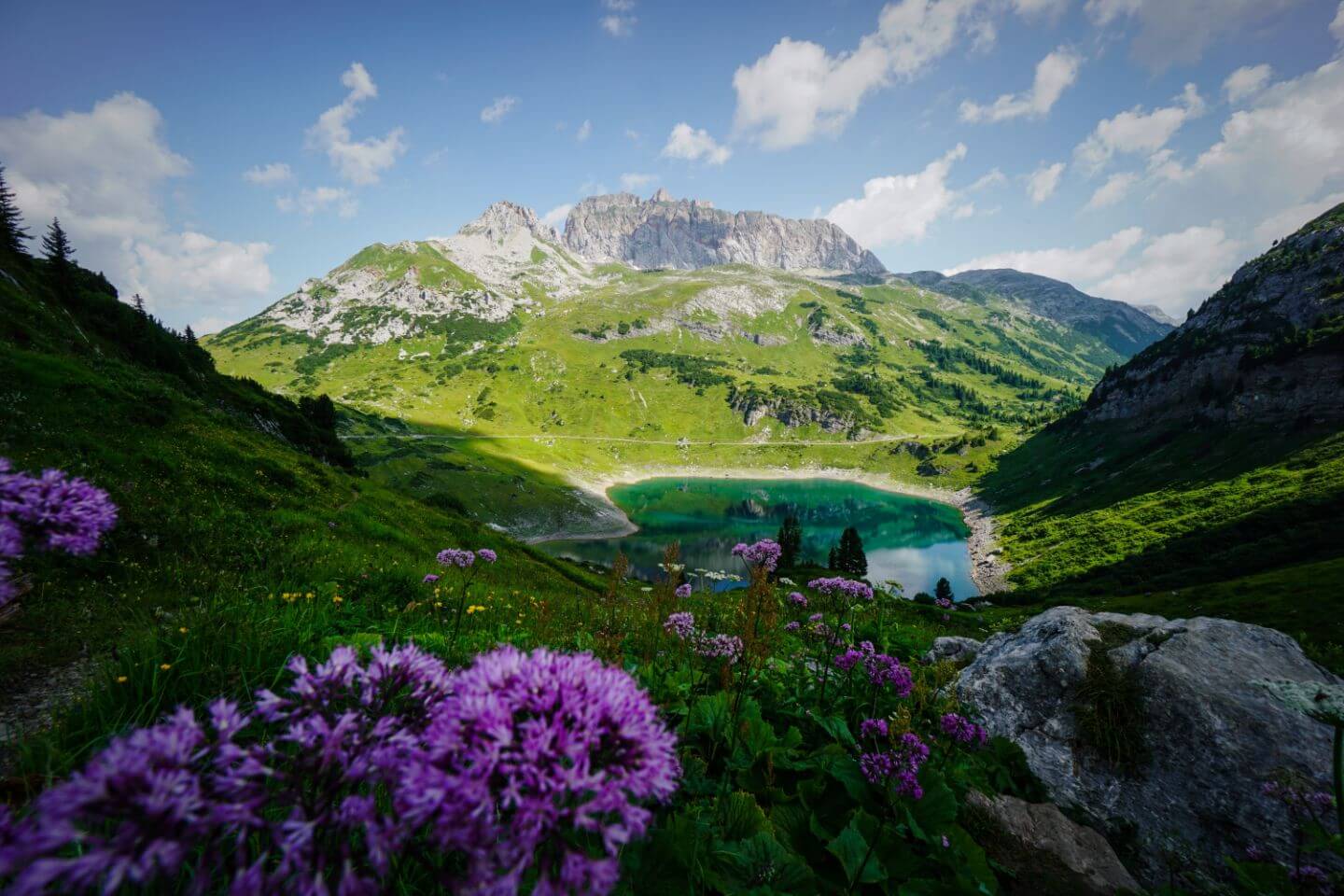
From the bus drop-off point, head down the gravel track towards Formarinsee and follow the road to Freiburger Hütte (1918 m).
You can also hike the narrow trail on the east side of the lake, which is more scenic.
As you near Freiburger Hütte, you’ll start to see Rote Wand (“Red Wall”, 2704 m), one of the most beloved mountains in the Lechquellen Gebirge.

Freiburger Hütte to Steinernes Meer (1 hour)

Wrap around Freiburger Hütte and follow signs to Steinernes Meer (signed 1:15 hours) and Spullersee (signed 4:15 hours).
You’ll gradually ascend on an earthy track up a verdant slope.
In July, the trail is awash with splashes of pale-pink Maiden’s Tears, purple Alpine calamint and Wood Cranesbill, yellow kidney vetch, and Mountain Arnica.
After hiking uphill for about 1.3 km, you’ll cross a pasture fence, and the rounded Formaletsch mountain comes into focus.
The trail levels out and continues horizontally along the south slope of Formaletsch.
Here, you’ll see the crystalline Verwall mountain range straight ahead.
Your hike will likely be enlivened by the sound of bells, as you’ll be traversing alpine pastures dotted with grazing cows and frolicking calves.
To learn more about alpine pasture safety, read our guide to Visiting the Alps in Summer.
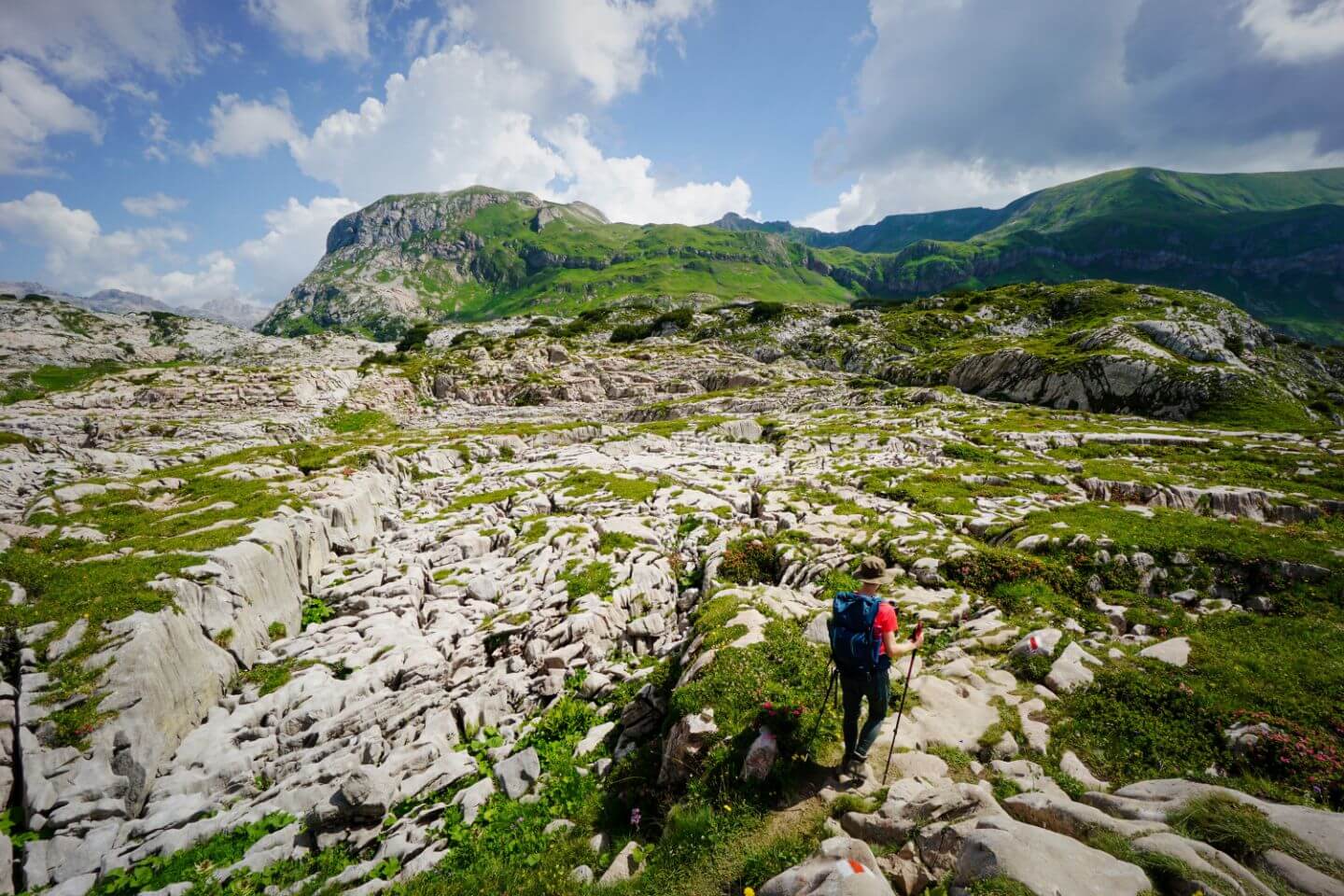
The easy path around Formaletsch delivers you to the Steinernes Meer, a karst landscape that is aptly called “Stone Sea.”
Steinernes Meer to Gehrengrat (1:30 hours)
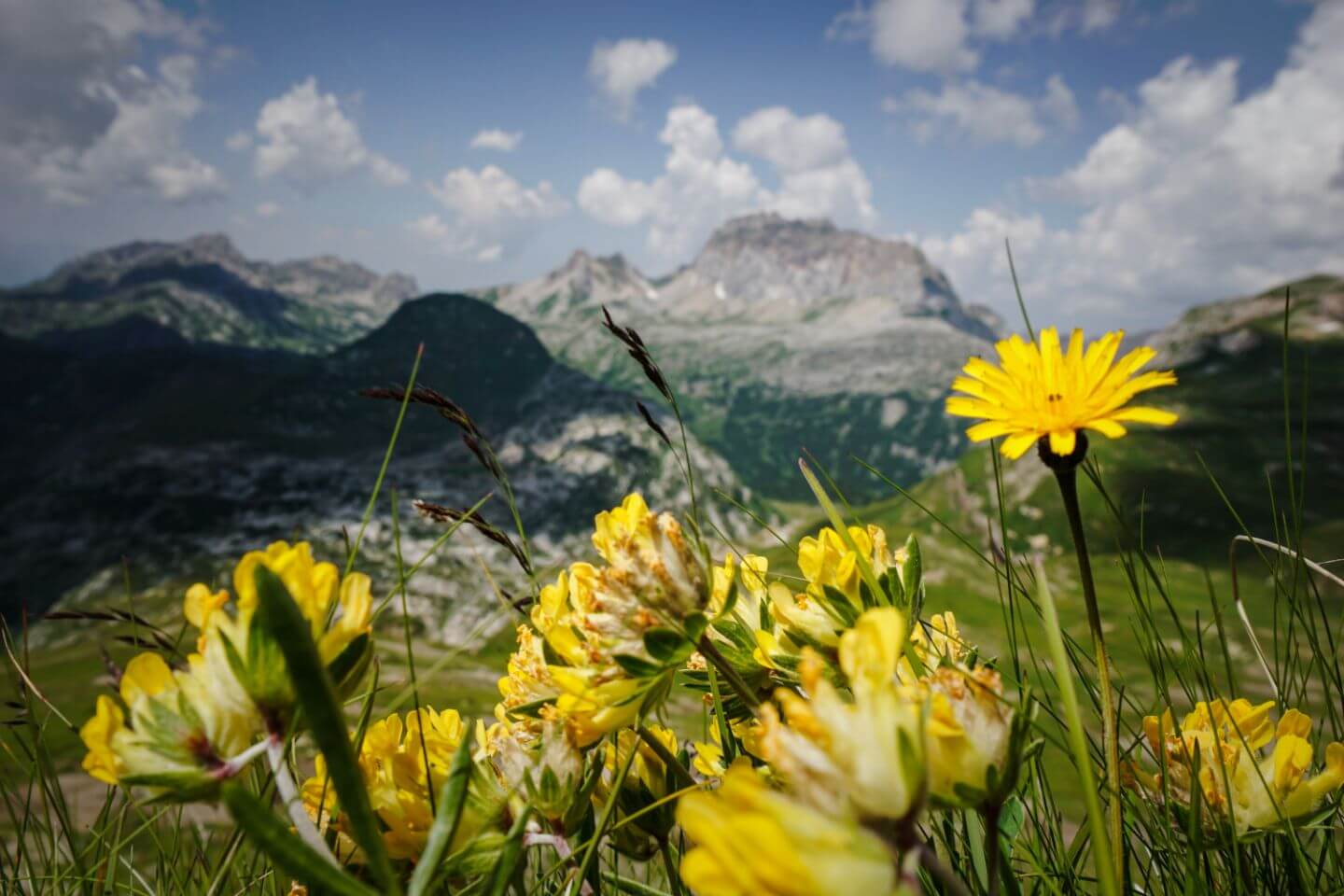
Following the red-painted waymarks, slowly cross the heather-grey Steinernes Meer (about 30 – 35 minutes).
Given the unevenness of the terrain, this part can get a bit exhausting, because each step requires concentration. Visually and geologically, however, this is a very exciting part of the trail.
When you reach the Steinernes Meer trail intersection, the hard part is over. Continue straight in the direction of Gehrengrat and Spullersee (signed 3 hours).
The path is level and you’ll cross a meadow, before beginning the 280 meter ascent to Gehrengrat ridge.
The ascent has some steep sections, but it’s mostly quite gentle because of the loamy terrain.
As mentioned earlier, if the conditions are “wet,” then this will be slippery and more difficult. The ascent concludes with a series of switchbacks.

As you glance back, the views of Rote Wand and the Lechquellen Mountains make you wish you were hiking in the opposite direction.
Don’t worry, your descent will be accompanied by equally marvelous vistas on the other side.
When you reach the top of Gehrengrat, you’ll see the limestone Rätikon and the crystalline Silvretta ranges, bordering Switzerland.
In the opposite direction, you’ll see Spullersee flanked by the dramatic Rohnspitze, Goppelsptize, and Wasenspitze.
Gehrengrat to Dalaaser Schütz (1 hour)
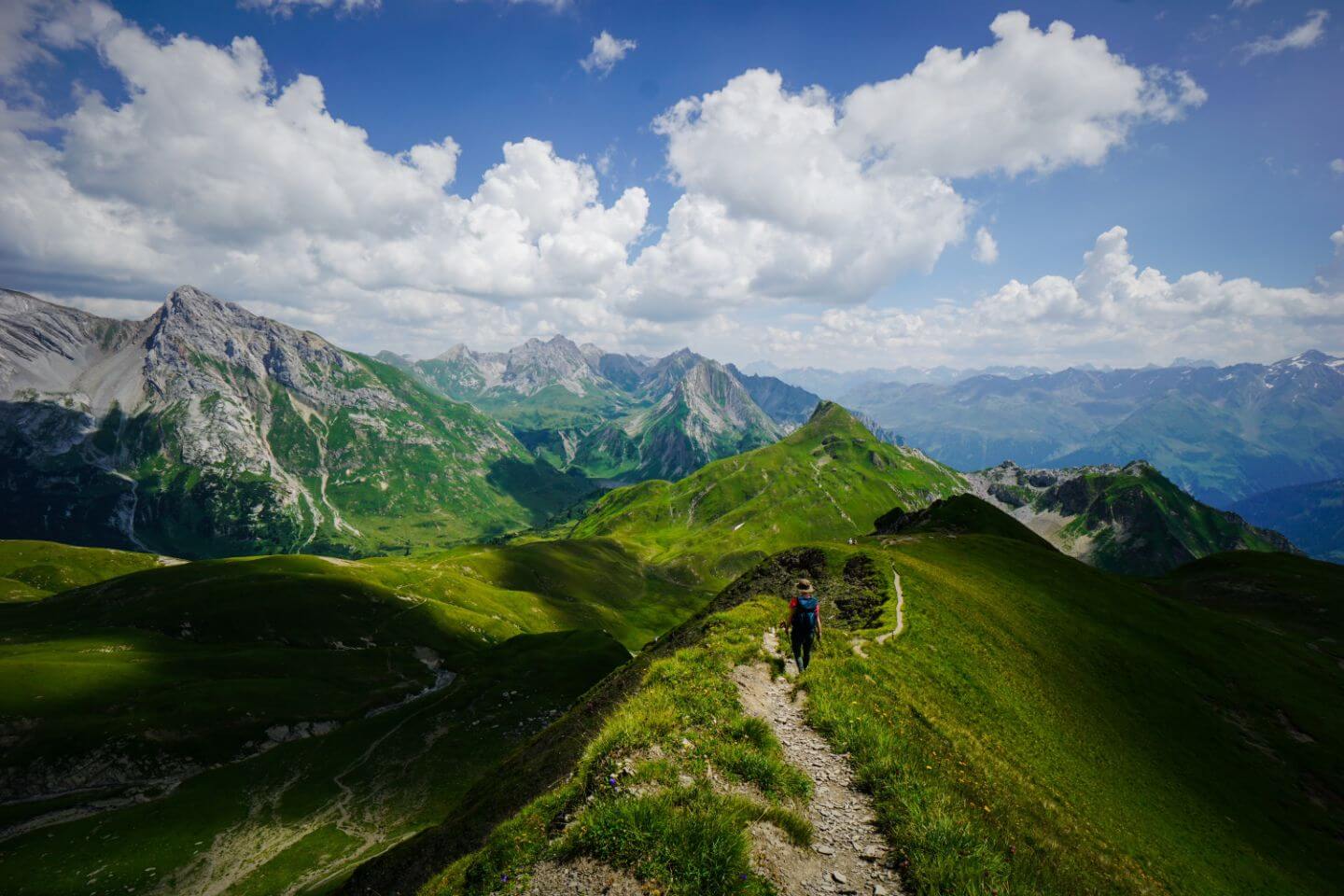
Following the ridge, descend in the direction of Spullersee. I was saying “wow” with every step. In some places, the trail is washed out and crumbling, which can be extremely problematic if you don’t have hiking poles or adequate footwear.
We recommend grade B/C high-cut hiking books like the women’s Hanwag Tatra II GTX / Meindl Schuhe Island Lady or the men’s Hanwag Tatra II GTX.
After navigating this steep descent, the trail levels out and you’ll cross the Glongbach stream, before gently descending across grassy meadows to the high valley of Dalaaser Schütz.
Dalaaser Schütz to Spullersee (40 minutes)

At the Dalaaser Schütz trail intersection, continue heading down along the wide track. Shortly thereafter, you’ll turn right, leaving the wide track, and follow the trail (there’s a waymark).
The trail continues to descend gently and you’ll glide right to Spullersee.
Shortly before reaching the lake, you’ll cross a meadow blooming with purple Gentian (Gentiana purpurea).
At the lake, head left and walk 10 minutes to the bus stop.

Related: Austrian Alps Hiking Destinations
How to Get Back to Lech am Arlberg from Spullersee
Bus 6 departs from Spullersee to Lech about 6 times a day. Current timetable (local bus).
Exact location Bus Stop Spullersee | Google Maps
The bus drives down the scenic Spulleralpe, stopping at Dalaaser Staffel, Abzweigung, Älpele, Zug Kirchle, on the way back to Rüfiplatz, Lech.
Duration | 30 Minutes
Where to Stay
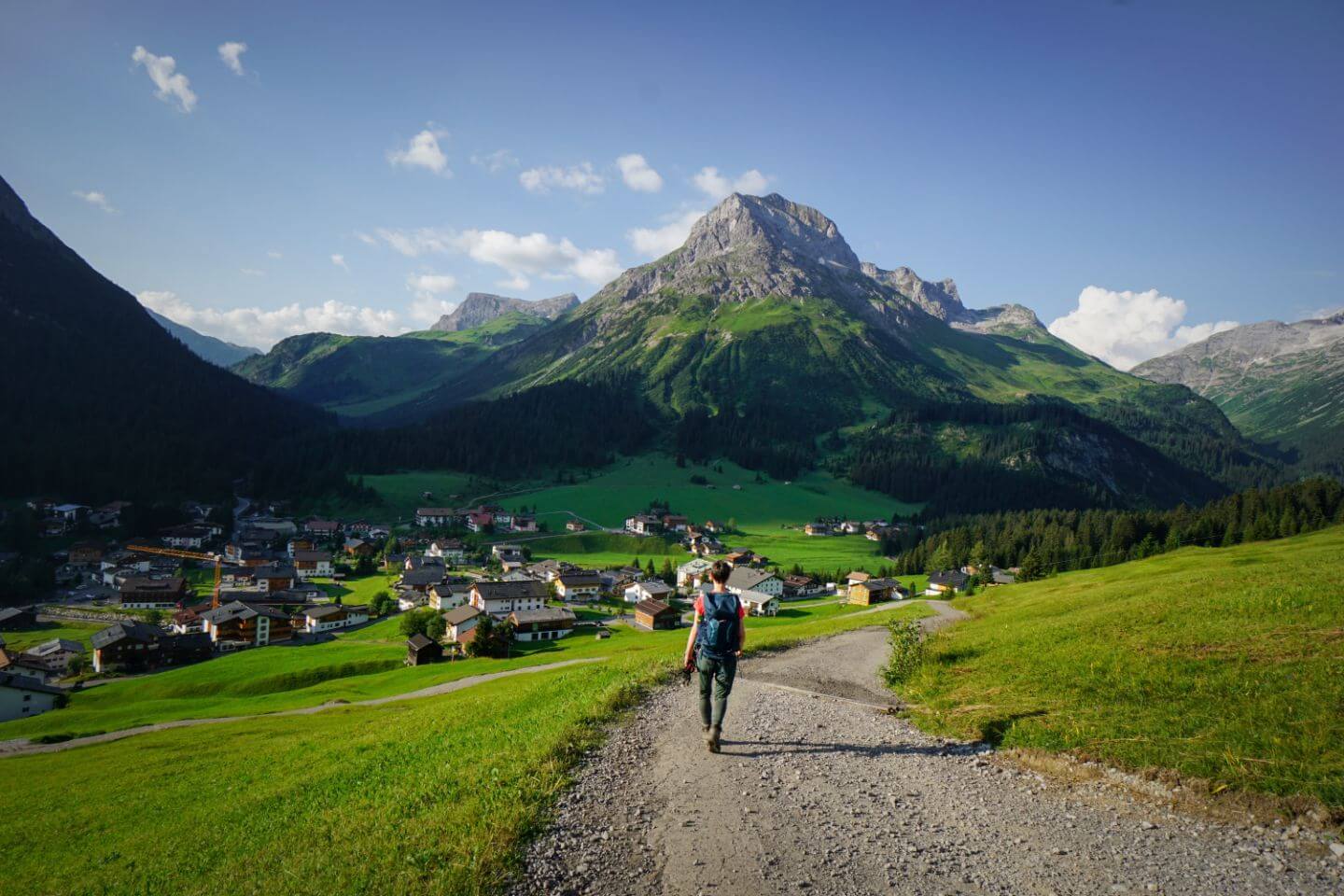
Walking from Oberlech to Lech
Lech am Arlberg

Lech am Arlberg is an alpine village in the Arlberg region of Vorarlberg.
It’s situated at an elevation of 1444 meters, between the Lechquellen Mountains and the Lechtal Alps. This darling destination is one of our favorite places to hike in Austria in summer.
You can take advantage of the regional summer busses to tackle a number of point-to-point hikes like Spuller Schafberg to Zug, the first stage of the Lechweg, Oberlech to Göppinger Hut, and Rüfikopf to Stuttgarter Hütte.
Budget | Lech Hostel is a budget-friendly accommodation in Lech am Arlberg, offering clean and cozy single, double, and triple rooms. Guests have access to a shared kitchen and shared lounge. Bathrooms are shared as well. The room rate is unbeatable.
Midrange | Hotel Garni Schneider is a top-rated, affordable bed and breakfast, situated next to Rüfikopfbahn in the center of Lech. Bedrooms are nicely decorated, spotless, and comfortable. Guests also have access to a wellness area (Finnish sauna, steam bath, Kneipp basins, and relaxation room) and free private parking.
Luxury | Hotel Auenhof is a family-run 4-star superior hotel, situated along the River Lech, facing Omeshorn. With its dreamy location and extraordinary staff, Hotel Auenhof outshines other Lech accommodations in terms of its hospitality and atmosphere. The highlight of staying here is the gourmet multi-course dinners, which delight with their creative ingredient combinations, flavors, and presentations. Many hotel restaurants strive to be innovative, but none so successfully as Hotel Auenhof. As a guest, you’ll also enjoy the generous, complimentary afternoon snacks and a very nice wellness area.
Luxury | Der Berghof is a sophisticated, 4-star superior hotel in the center of Lech. This hotel delivers an unparalleled experience in terms of style, comfort, wellness and cuisine. Bedrooms are designed with premium materials and furnished with extraordinary attention to detail. The wellness area features five modern saunas, a cold water basin, and a foot bath. The breakfast was extraordinary.
Look for accommodation in Lech.
Oberlech

Luxury | Hotel Sonnenburg is the perfect hotel for families with children and literature lovers.
You’ll find books in your room, by the pool, in the lobby, and in the hotel library. The hotel also holds literature events throughout the year as well as rotating exhibitions.
During our visit, there was an inclusive “Alles Familie” (All Families) children’s book exhibit, showcasing all types of families.
Childcare is provided on most days for at least several hours. And, there are also playrooms for kids.
Our favorite thing about Hotel Sonnenburg was our room. We just melted into the bed. The comforters are deluxe and the rooms are designed intentionally, exhibiting functional sophistication.
There’s space for everything and you really feel like you’re on vacation.
One last thing – breakfast is lavish. It’s like an ancient Roman banquet. It does not end. If we had to rank Austrian hotels based on breakfast, Hotel Sonnenburg would place number one.
Book your stay at Hotel Sonnenburg.

GET YOUR FREE EBOOK
Signup for our newsletter to get our guide to “Secret Hiking Destinations in Europe.”
Austria Trip Planning Essentials
Use our Austria Travel Guide and Austria blog archive to plan a unique and memorable trip to Austria.
When to Visit Austria
Summer and early Fall are our favorite seasons in Austria.
Getting around Austria
Austria has an excellent public transit system. We’ve used it extensively to travel throughout the country. We highly recommend using transit if you’re visiting cities (Vienna, Salzburg, Innsbruck, Graz, etc…), and/or doing hut-to-hut hikes.
Some areas like Mayrhofen, Schladming and Lech am Arlberg have wonderful seasonal transit systems in place (e.g. summer hiking buses). However, if you’re not visiting during the high season, bus frequencies are significantly reduced and it’s far easier to get around with your own vehicle.
If you’re planning on visiting multiple destinations across Austria, we recommend renting a car.
Use these road trip itineraries for trip planning inspiration:
- 2 Week Austria Road Trip – starting in Vienna
- 1 Week Austria Road Trip – starting in Salzburg or Munich
- 10-Day Bavarian Alps & Tyrolean Alps Road Trip – starting in Munich
Car Rental
We recommend using the Discovercars.com car rental reservation platform to search for and book car rentals. This easy-to-use booking platform compares car rental deals from 500+ trusted providers, so that you can choose the best option for your trip.
If you’re driving into Austria from a neighboring country, don’t forget to purchase a vignette at/near the border.
Hiking in Austria
Where to Hike in Austria
Read Austrian Alps Hiking Destinations for an overview of where to hike in Austria, with tips on specific trails and where to stay. Also check out Best Day Hikes in Austria and these region-specific hiking guides:
- Salzburg Hiking Guide
- Filzmoos, Salzburg Hiking Guide
- Schladming, Styria Hiking Guide
- Lech am Arlberg, Vorarlberg Hiking Guide
- Vorarlberg Hiking Guide
- Vienna Mountains Hiking Guide
Hut to Hut Hiking in Austria
Austria is a premier hut-to-hut and long-distance hiking destination. The quality of the mountain huts are superb. We particularly love the high-alpine trails, which are called Höhenwege in German. We’ve summarized our favorite multi-day hikes in Trekking Austria. If you’re new to hut hiking, read this in-depth guide to Hut to Hut Hiking in Austria.
Hiking Essentials
- Day Pack: Osprey Tempest 30 Women’s Backpack / Osprey Talon 33 Men’s Backpack
- Grade B/C high-cut hiking boots: Meindl Schuhe Island Lady (Kati’s Boots), Women’s Hanwag Tatra II GTX (Sabrina’s Boots), Men’s Hanwag Tatra II GTX (men’s equivalent)
- CAT 4 Sunglasses: Julbo Shield Mountain Sunglasses
- Hiking Poles: Black Diamond Trail Trekking Poles
- Backpack Camera Clip: Peak Design Camera Clip
What to See & Do in Austria
- Visit a gorge like the Liechtenstein Gorge in Salzburg.
- Bathe in the thermal pools of an Austrian Therme like Aqua Dome in Tirol
- Stay in a thermal spa hotel like Rogner Bad Blumau in Styria, EurothermenResort Bad Ischl in Upper Austria, or the Aqua Dome Hotel in Tirol.
- Hike to a mountain lake like Lake Tappenkarsee in Salzburg or Lake Drachensee in Tirol.
- Go Wine Tasting in South Styria.
- Marvel at the culture, music, and architecture of Vienna.
- Eat heartwarming mountain food in an Almhütte at Grosser Ahornboden in Tirol or Ursprungalm in Styria.
- Drive the Grossglockner High Alpine Road in Hohe Tauern National Park.
- Visit the castles, monasteries, and wine taverns of the Wachau Valley, a UNESCO World Heritage Site.
Austrian Hotels
- Best Hotels in the Austrian Alps
- Best Hotels in Lech am Arlberg, Vorarlberg
- Wellness Hotel Theresa, Zillertal, Tirol
- Hotel Eder in Maria Alm, Salzburg
Vorarlberg Hiking Trails
Vorarlberg:
European Alps:
- The Alps in Summer: 10 Things You Need to Know Before Visiting
- Hiking in the European Alps: Invaluable Tips
This post may contain affiliate links.